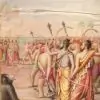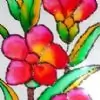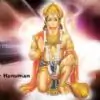Originally posted by: "1:18:12-15"
kausalyaa shushubhe tena putreNa amita tejasaa |
yathaa vareNa devaanaam aditiH vajra paaNinaa || 1-18-12
12. Kausalya; a+mita tejasaa= one with unlimited resplendence; tena putreNa= by that, son; devaanaam vareNa= among gods, the best one; vajra paaNinaa= by Thunderbolt, in hand [wielder - Indra]; adithiH yathaa shushubhe= Lady Aditi, as with, shone forth.
Kausalya shone forth with such a son whose resplendence is unlimited, as with lady Aditi who once stood out with her son Indra, the best one among gods. [1-18-12]
Verse Locator
bharato naama kaikeyyaam jaj~ne satya paraakramaH |
saakSaat viSNoH caturtha bhaagaH sarvaiH samudito guNaiH || 1-18-13
13. satya paraakramaH= truthfulness, as his valour; saakshaat viSNoH= manifest, Vishnu's; chatur bhaagaH= fourth, component; sarvaiH guNaiH samuditaH= with all, merits, embodied with ; Bharata; naama kaikeyyaam jaj~ne= named, to Queen Kaikeyi, born to.
Queen Kaikeyi gave birth to Bharata, one embodied with all merits, and whose truthfulness itself is his valour and who is fourth component of manifest Vishnu, namely Rama. [1-18-13]
The fraction indicated here like 'one fourth of Vishnu' etc may be reckoned as the share of the dessert consumed by the queens, but not as a cleaved portion of Vishnu as he is an indivisible entity. Here it is half of one-fourth i.e., one-eighth of dessert given to Kaikeyi.
Verse Locator
atha laxmaNa shatrughnau sumitraa ajanayat sutau |
viirau sarva astra kushalau viSNoH ardha samanvitau | 1-18-14
14. atha= then; Queen Sumitra; viiraau= valiant ones; sarva astra kushalau= all, weaponry, experts; viSNoH= Vishnu's; artha= essence, epitome; samanvitou= those that are embodied with; Lakshmana; Shatrughna; sutou ajanayat= to sons, gave birth.
Queen Sumitra then gave birth to two sons who are the embodied epitomes of Vishnu, namely Lakshmana, and Shatrughna, who are valiant ones and experts in all kinds of weaponry. [1-18-14]
Verse Locator
puShye jaataH tu bharato mIna lagne prasanna dhIH |
saarpe jaatau tu saumitrI kuLIre abhyudite ravau || 1-18-15
15. prasanna dhiiH= level, headed one – guileless, fair-minded; Bharata; pushye miina lagne jaataH= under Pushyami star, in Pisces [of Zodiac,] born; saumitrii= sons of Sumitra [Lakshmana, Shatrughna]; saarpe kuliire= under star presided by serpent [aaSreSa,] in Cancer [of Zodiac]; abhyudite ravau= when rising, of Sun- when sun is rising, i.e., on next day of Rama's birth, tenth of Chaitra; jaatau= they are born.
The fair-minded Bharata is born under Pisces where puSyami is the star of day, and the sons of Sumitra, namely Lakshmana and Shatrughna are born under Cancer, where aaSreSa is the star of the day and when sun is rising. [1-18-15]
Rama is born on the ninth day of Chaitra month, and Bharata is born in the earlier part of next day the tenth of Chaitra, earlier to his younger brothers, and then Lakshmana and Shatrughna are born on the later part of the day.
'Pushya is the name of a month; but here it means the eighth mansion. The ninth is called Aslesh, or the snake. It is evident from this that Bharata, though his birth is mentioned before that of the twins, was the youngest of the four brothers and Rama's junior by eleven months' Schlegel. The eleven-month gap between Rama and Bharata is unapparent in the words of verse. This may be from some other version of Ramayana.
[/quote]
The author notes in blue are obviously his/her interpretations, rather than Valmiki's. Particularly the observation about Bharat being the youngest, in face of the evidence. But that still leaves open the question of why Rama himself describes Lakshman as the #2, as in 6-128. I tried the site you provided for more details, but it is still a work in progress, and only has until Sarg 88.

























